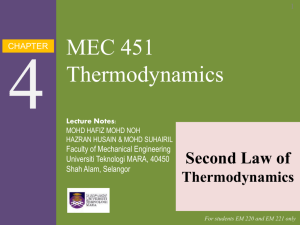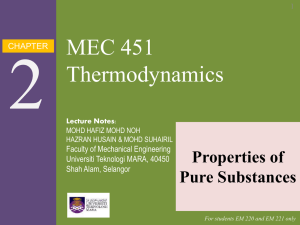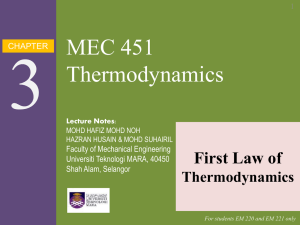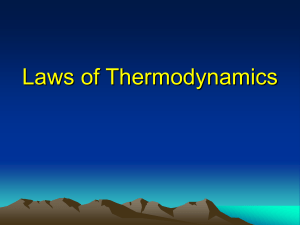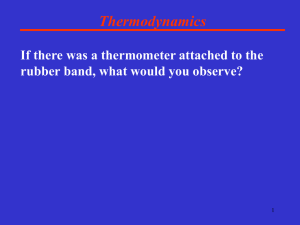chap4secondlawofthermodynamics
advertisement
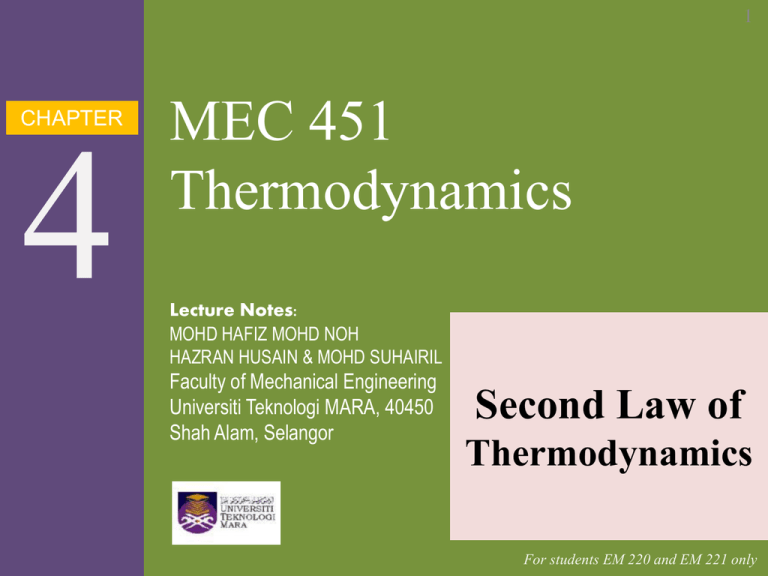
1 CHAPTER 4 MEC 451 Thermodynamics Lecture Notes: MOHD HAFIZ MOHD NOH HAZRAN HUSAIN & MOHD SUHAIRIL Faculty of Mechanical Engineering Universiti Teknologi MARA, 40450 Shah Alam, Selangor Second Law of Thermodynamics For students EM 220 and EM 221 only Faculty of Mechanical Engineering, UiTM Introduction A process must satisfy the first law in order to occur. Satisfying the first law alone does not ensure that the process will take place. Second law is useful: provide means for predicting the direction of processes, establishing conditions for equilibrium, determining the best theoretical performance of cycles, engines and other devices. 2 MEC 451 – THERMODYNAMICS Faculty of Mechanical Engineering, UiTM A cup of hot coffee does not get hotter in a cooler room. Transferring heat to a paddle wheel will not cause it to rotate. Transferring heat to a wire will not generate electricity. These processes cannot occur even though they are not in violation of the first law. 3 MEC 451 – THERMODYNAMICS Faculty of Mechanical Engineering, UiTM Second Law of Thermodynamics Kelvin-Planck statement No heat engine can have a thermal efficiency 100 percent. As for a power plant to operate, the working fluid must exchange heat with the environment as well as the furnace. 4 MEC 451 – THERMODYNAMICS Faculty of Mechanical Engineering, UiTM Heat Engines Work can easily be converted to other forms of energy, but? Heat engine differ considerably from one another, but all can be characterized : o they receive heat from a high-temperature source o they convert part of this heat to work o they reject the remaining waste heat to a lowtemperature sink atmosphere o they operate on a cycle 5 MEC 451 – THERMODYNAMICS Faculty of Mechanical Engineering, UiTM The work-producing device that best fit into the definition of a heat engine is the steam power plant, which is an external combustion engine. 6 MEC 451 – THERMODYNAMICS Faculty of Mechanical Engineering, UiTM Thermal Efficiency Represent the magnitude of the energy wasted in order to complete the cycle. A measure of the performance that is called the thermal efficiency. Can be expressed in terms of the desired output and the required input Desired Result th Required Input For a heat engine the desired result is the net work done and the input is the heat supplied to make the cycle operate. MEC 451 – THERMODYNAMICS 7 Faculty of Mechanical Engineering, UiTM The thermal efficiency is always less than 1 or less than 100 percent. th where Wnet , out Qin Wnet , out Wout Win Qin Qnet 8 MEC 451 – THERMODYNAMICS Faculty of Mechanical Engineering, UiTM Applying the first law to the cyclic heat engine Qnet , in Wnet , out U Wnet , out Qnet , in Wnet , out Qin Qout The cycle thermal efficiency may be written as th Wnet , out Qin Qin Qout Qin Qout 1 Qin MEC 451 – THERMODYNAMICS 9 Faculty of Mechanical Engineering, UiTM A thermodynamic temperature scale related to the heat transfers between a reversible device and the high and lowtemperature reservoirs by QL TL QH TH The heat engine that operates on the reversible Carnot cycle is called the Carnot Heat Engine in which its efficiency is th , rev TL 1 TH 10 MEC 451 – THERMODYNAMICS Faculty of Mechanical Engineering, UiTM Heat Pumps and Refrigerators A device that transfers heat from a low temperature medium to a high temperature one is the heat pump. Refrigerator operates exactly like heat pump except that the desired output is the amount of heat removed out of the system The index of performance of a heat pumps or refrigerators are expressed in terms of the coefficient of performance. 11 MEC 451 – THERMODYNAMICS Faculty of Mechanical Engineering, UiTM 12 MEC 451 – THERMODYNAMICS Faculty of Mechanical Engineering, UiTM COPHP QH QH Wnet , in QH QL QL COPR Wnet , in 13 MEC 451 – THERMODYNAMICS Faculty of Mechanical Engineering, UiTM Carnot Cycle Process Description 1-2 Reversible isothermal heat addition at high temperature 2-3 Reversible adiabatic expansion from high temperature to low temperature 3-4 Reversible isothermal heat rejection at low temperature 4-1 Reversible adiabatic compression from low temperature to high temperature 14 MEC 451 – THERMODYNAMICS Faculty of Mechanical Engineering, UiTM Execution of Carnot cycle in a piston cylinder device 15 MEC 451 – THERMODYNAMICS Faculty of Mechanical Engineering, UiTM 16 MEC 451 – THERMODYNAMICS Faculty of Mechanical Engineering, UiTM The thermal efficiencies of actual and reversible heat engines operating between the same temperature limits compare as follows The coefficients of performance of actual and reversible refrigerators operating between the same temperature limits compare as follows 17 MEC 451 – THERMODYNAMICS Faculty of Mechanical Engineering, UiTM Example 4.1 A steam power plant produces 50 MW of net work while burning fuel to produce 150 MW of heat energy at the high temperature. Determine the cycle thermal efficiency and the heat rejected by the cycle to the surroundings. Solution: th Wnet , out QH 50 MW 0.333 or 33.3% 150 MW Wnet , out QH QL QL QH Wnet , out 150 MW 50 MW 100 MW 18 MEC 451 – THERMODYNAMICS Faculty of Mechanical Engineering, UiTM Example 4.2 A Carnot heat engine receives 500 kJ of heat per cycle from a hightemperature heat reservoir at 652ºC and rejects heat to a lowtemperature heat reservoir at 30ºC. Determine : (a) The thermal efficiency of this Carnot engine (b) The amount of heat rejected to the low-temperature heat reservoir Solution: TH = 652oC th , rev 1 QH WOUT HE QL TL = 30oC TL TH (30 273) K 1 (652 273) K 0.672 or 67.2% QL TL QH TH (30 273) K 0.328 (652 273) K QL 500 kJ (0.328) 164 kJ 19 MEC 451 – THERMODYNAMICS Faculty of Mechanical Engineering, UiTM Example 4.3 An inventor claims to have developed a refrigerator that maintains the refrigerated space at 2ºC while operating in a room where the temperature is 25ºC and has a COP of 13.5. Is there any truth to his claim? Solution: TH = 25oC QL TL QH QL TH TL (2 273) K (25 2) K 1196 . COPR QH Win R QL TL = 2oC - this claim is also false! 20 MEC 451 – THERMODYNAMICS Faculty of Mechanical Engineering, UiTM Supplementary Problem 4.1 1. A 600 MW steam power plant, which is cooled by a river, has a thermal efficiency of 40 percent. Determine the rate of heat transfer to the river water. Will the actual heat transfer rate be higher or lower than this value? Why? [900 MW] 2. A steam power plant receives heat from a furnace at a rate of 280 GJ/h. Heat losses to the surrounding air from the steam as it passes through the pipes and other components are estimated to be about 8 GJ/h. If the waste heat is transferred to the cooling water at a rate of 145 GJ/h, determine (a) net power output and (b) the thermal efficiency of this power plant. [ 35.3 MW, 45.4% ] 3. An air conditioner removes heat steadily from a house at a rate of 750 kJ/min while drawing electric power at a rate of 6 kW. Determine (a) the COP of this air conditioner and (b) the rate of heat transfer to the outside air. [ 2.08, 1110 kJ/min ] 21 MEC 451 – THERMODYNAMICS Faculty of Mechanical Engineering, UiTM 4. Determine the COP of a heat pump that supplies energy to a house at a rate of 8000 kJ/h for each kW of electric power it draws. Also, determine the rate of energy absorption from the outdoor air. [ 2.22, 4400 kJ/h ] 5. An inventor claims to have developed a heat engine that receives 700 kJ of heat from a source at 500 K and produces 300 kJ of net work while rejecting the waste heat to a sink at 290 K. Is this reasonable claim? 6. An air-conditioning system operating on the reversed Carnot cycle is required to transfer heat from a house at a rate of 750 kJ/min to maintain its temperature at 24oC. If the outdoor air temperature is 35oC, determine the power required to operate this air-conditioning system. [ 0.463 kW ] 7. A heat pump is used to heat a house and maintain it at 24oC. On a winter day when the outdoor air temperature is -5oC, the house is estimated to lose heat at a rate of 80,000 kJ/h. Determine the minimum power required to operate this heat pump. [ 2.18 kW ] MEC 451 – THERMODYNAMICS 22 Faculty of Mechanical Engineering, UiTM Entropy The 2nd law states that process occur in a certain direction, not in any direction. It often leads to the definition of a new property called entropy, which is a quantitative measure of disorder for a system. Entropy can also be explained as a measure of the unavailability of heat to perform work in a cycle. This relates to the 2nd law since the 2nd law predicts that not all heat provided to a cycle can be transformed into an equal amount of work, some heat rejection must take place. 23 MEC 451 – THERMODYNAMICS Faculty of Mechanical Engineering, UiTM Entropy Change The entropy change during a reversible process is defined as For a reversible, adiabatic process dS 0 S2 S1 The reversible, adiabatic process is called an isentropic process. 24 MEC 451 – THERMODYNAMICS Faculty of Mechanical Engineering, UiTM Entropy Change and Isentropic Processes The entropy-change and isentropic relations for a process can be summarized as follows: i. Pure substances: Any process: Δs = s2 – s1 (kJ/kgK) Isentropic process: s2 = s1 ii. Incompressible substances (liquids and solids): Any process: s2 – s1 = cav T2/T1 (kJ/kg Isentropic process: T2 = T1 25 MEC 451 – THERMODYNAMICS Faculty of Mechanical Engineering, UiTM iii. Ideal gases: a) constant specific heats (approximate treatment): for all process T2 v2 s2 s1 Cv , av ln R ln T1 v1 T2 P2 s2 s1 C p, av ln R ln T1 P1 for isentropic process P2 v1 P1 s const . v2 k 26 MEC 451 – THERMODYNAMICS Faculty of Mechanical Engineering, UiTM Example 4.5 Steam at 1 MPa, 600oC, expands in a turbine to 0.01 MPa. If the process is isentropic, find the final temperature, the final enthalpy of the steam, and the turbine work. Solution: mass balance : m1 m2 m energy balance Ein Eout m1h1 m2 h2 Wout Wout m h1 h2 State1 sup erheated P1 1 MPa kJ h 3698.6 1 kg T1 600o C s1 8.0311 kgkJ.K 27 MEC 451 – THERMODYNAMICS Faculty of Mechanical Engineering, UiTM Since that the process is isentropic, s2=s1 Work of turbine Wout h1 h2 State 2 3698.6 2545.6 P2 0.01 MPa sat.mixture s2 8.0311 kgkJ. K x2 0.984 h2 191.8 0.984 2392.1 1153 kJ kg 2545.6 kJ kg T2 Tsat @ P2 45.81o C 28 MEC 451 – THERMODYNAMICS Faculty of Mechanical Engineering, UiTM Isentropic Efficiency for Turbine 29 MEC 451 – THERMODYNAMICS Faculty of Mechanical Engineering, UiTM Isentropic Efficiency for Compressor 30 MEC 451 – THERMODYNAMICS Faculty of Mechanical Engineering, UiTM Example 4.6 Steam at 1 MPa, 600°C, expands in a turbine to 0.01 MPa. The isentropic work of the turbine is 1152.2 kJ/kg. If the isentropic efficiency of the turbine is 90 percent, calculate the actual work. Find the actual turbine exit temperature or quality of the steam. Solution: Theoretically: isen ,T wa h1 h2 a ws h1 h2 s wa isen ,T ws 0.9 1153 1037.7 kJ kg 31 MEC 451 – THERMODYNAMICS Faculty of Mechanical Engineering, UiTM State1 kJ P1 1 MPa h1 3698.6 kg T1 600o C s1 8.0311 kgkJ. K State 2 s sat.mixture P2 0.01 MPa x2 s 0.984 kJ s2 s s1 8.0311 kg . K h 2545.6 kJ 2s kg Obtain h2a from Wa wa h1 h2 a h2 a h1 wa 2660.9 kJ kg State 2a P2 0.01 MPa sup erheated o h2 a 2660.9 kJ T 86.85 C kg 2a 32 MEC 451 – THERMODYNAMICS Faculty of Mechanical Engineering, UiTM Example 4.7 Air enters a compressor and is compressed adiabatically from 0.1 MPa, 27°C, to a final state of 0.5 MPa. Find the work done on the air for a compressor isentropic efficiency of 80 percent. Solution: From energy balance Wc , s m h2 s h1 Wc , s Wc , s m h2 s h1 For isentropic process of IGL T2 s T1 P2 P1 k 1 k 0.5 T2 s 27 273 0.1 475.4 K 0.4/1.4 Then Wc , s 1.005 475.4 300 176 kJ kg Wc ,a Wc ,s isen,c CP T2 s T1 220 kJ kg 33 MEC 451 – THERMODYNAMICS Faculty of Mechanical Engineering, UiTM Supplementary Problems 4.2 1. The radiator of a steam heating system has a volume of 20 L and is filled with the superheated water vapor at 200 kPa and 150oC. At this moment both inlet and exit valves to the radiator are closed. After a while the temperature of the steam drops to 40oC as a result of heat transfer to the room air. Determine the entropy change of the steam during this process. [ -0.132 kJ/.K ] 2. A heavily insulated piston-cylinder device contains 0.05 m3 of steam at 300 kPa and 150oC. Steam is now compressed in a reversible manner to a pressure of 1 MPa. Determine the work done on the steam during this process. [ 16 kJ ] 3. A piston –cylinder device contains 1.2 kg of nitrogen gas at 120 kPa and 27oC. The gas is now compressed slowly in a polytropic process during which PV1.3=constant. The process ends when the volume is reduced by one-half. Determine the entropy change of nitrogen during this process. [ -0.0617 kJ/kg.K ] 34 MEC 451 – THERMODYNAMICS Faculty of Mechanical Engineering, UiTM 4. Steam enters an adiabatic turbine at 8 MPa and 500oC with a mass flow rate of 3 kg/s and leaves at 30 kPa. The isentropic efficiency of the turbine is 0.90. Neglecting the kinetic energy of the steam, determine (a) the temperature at the turbine exit and (b) the power output of the turbine. [ 69.09oC,3054 kW ] 5. Refrigerant-R134a enters an adiabatic compressor as saturated vapor at 120 kPa at a rate of 0.3 m3/min and exits at 1 MPa pressure. If the isentropic efficiency of the compressor is 80 percent, determine (a) the temperature of the refrigerant at the exit of the compressor and (b) the power input, in kW. Also, show the process on a T-s diagram with respect to the saturation lines. [ 58.9oC,1.70 kW ] 35 MEC 451 – THERMODYNAMICS
